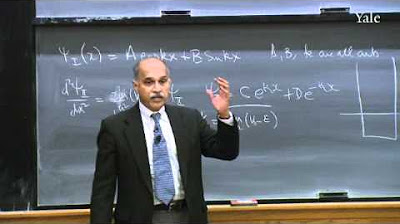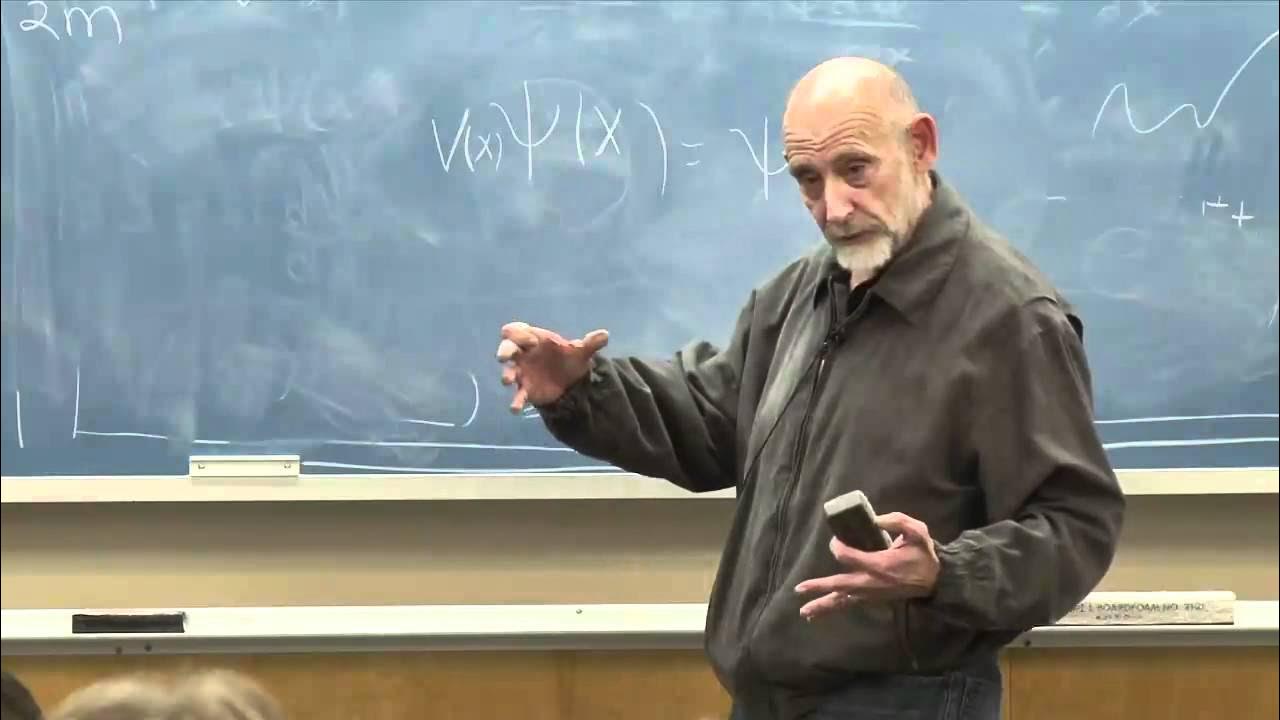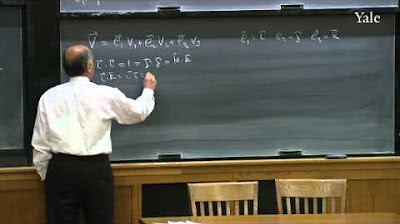Visualization of Quantum Physics (Quantum Mechanics)
TLDRThis video script explores the contrast between classical physics and quantum physics through simulations of a particle's movement. Initially, it presents classical physics, where a particle's position and velocity are deterministic. It then transitions to quantum physics, highlighting the probabilistic nature of particle location and the wave function's role in describing both position and velocity. The script delves into the Schrödinger equation, wave function collapse, and the Heisenberg uncertainty principle, demonstrating how uncertainty in position correlates with uncertainty in velocity. The video concludes by discussing units of measurement and their impact on the interpretation of wave functions.
Takeaways
- 🌟 Classical physics assumes particles maintain a constant velocity in one-dimensional space.
- 📍 In classical physics, knowing the initial state allows for the prediction of future states.
- 🌊 Quantum physics describes particles using wave functions that contain information about position and velocity.
- 🔄 The wave function evolves over time according to the Schrödinger equation, representing the probability distribution of a particle's position.
- 📊 The probability of finding a particle is higher at points where the wave function's distance from the axis is greater.
- 🔢 Quantum indeterminism means we cannot predict the exact outcome of a measurement, only the probabilities.
- 💥 Measurement in quantum physics causes wave function collapse, zeroing out the probabilities outside the observed range.
- 🔄 Different wave functions can represent the same particle, each rotating differently and containing information about velocity.
- 🌀 The Fourier Transform decomposes wave functions into frequencies, providing a more readable form of the information.
- 📈 The uncertainty principle states that the more precisely we know a particle's position, the less we know about its velocity, and vice versa.
- 🌍 The concept of momentum is the product of mass and velocity, and is related to the shape of the wave function.
Q & A
What is the initial position and velocity of the particle in the simulation?
-The particle initially starts at position zero and has a velocity of 4 units per second.
How does time manipulation affect the simulation?
-Time is slowed down by a factor of two in the simulation to better observe the particle's behavior.
What is the role of the wave function in quantum physics as described in the simulation?
-The wave function in quantum physics represents both the position and velocity of the particle, providing a probability distribution rather than a definite location and speed.
How does the wave function change over time?
-The wave function evolves with time according to the Schrödinger equation, and in the simulation, it is shown to glide to the right at the particle's velocity.
What is the significance of the measurement device in the simulation?
-The measurement device can detect the particle within a specific range and demonstrates the indeterminism of quantum physics, as it cannot predict with certainty whether the particle will be within the range or not.
What happens to the wave function during a measurement?
-During a measurement, the wave function undergoes a process called wave function collapse, where the part of the wave outside the measurement range gets zeroed out if the result is 'yes', or the part inside the range is zeroed out if the result is 'no'.
How does the Fourier Transform relate to the wave function?
-The Fourier Transform decomposes the wave function into its constituent frequencies, creating a new wave function that provides information about the particle's velocity or momentum.
What is the significance of the uncertainty principle in quantum physics?
-The uncertainty principle states that there is a limit to how precisely we can know both the position and velocity (or momentum) of a particle simultaneously. The more precisely one of these properties is known, the less precisely the other can be determined.
How does the mass of a particle affect its wave function and the uncertainty principle?
-The mass of a particle affects the relationship between its momentum and velocity. A more massive particle will have a lower velocity for the same momentum, and the uncertainty principle remains the same, but the values of momentum translate to much lower velocities for heavier particles.
What units of measurement are used in the simulation?
-The simulation does not assume any particular units initially, but later on, for the position wave function, centimeters are chosen for convenience, and the mass of the particle is assumed to be the same value as the reduced Planck constant in kilograms.
How does the uncertainty in position affect the spreading of the position wave?
-If the uncertainty in position is initially low, the position wave will spread very fast, and vice versa. If the uncertainty in velocity is low, the spreading phenomenon will hardly be noticeable.
Outlines
🌟 Introduction to Particle Simulation and Quantum vs Classical Physics
This paragraph introduces a video simulation of a small particle's movement, initially using classical physics assumptions within a one-dimensional space. The particle starts at position zero with an initial velocity of 4 units per second. The simulation demonstrates the particle maintaining a constant velocity in empty space, with time slowed down by a factor of two. The paragraph transitions into explaining quantum physics, describing the particle with a wave function that contains information about its position and velocity. The wave function's rotation and varying distances from the main axis indicate the probability distribution of the particle's position. The Schrödinger equation is mentioned as governing the wave function's evolution over time. The simulation also includes a measurement device that can detect the particle within a certain range, illustrating the determinism of classical physics and the indeterminism of quantum physics through the concept of wave function collapse.
📊 Wave Function Collapse and the Role of Measurement
This paragraph delves into the measurement's impact on the wave function, leading to its collapse. It explains how the wave function evolves differently after measurement due to its altered state. The concept of multiple wave functions that provide the same positional information but rotate differently is introduced. The paragraph discusses the use of the Fourier Transform to decompose the wave function into frequencies, which helps in understanding the particle's velocity. The spreading phenomenon observed in the simulation is attributed to the particle's velocity wave function. The paragraph also contrasts classical physics with quantum physics by demonstrating how a cluster of particles moves according to the position and velocity wave functions, and how the inverse Fourier transform can reconstruct the original wave function. The relationship between the wave functions and their impact on position and velocity is highlighted.
🔄 The Heisenberg Uncertainty Principle and Its Implications
This paragraph discusses the Heisenberg Uncertainty Principle, which states that the product of the uncertainties in position and momentum (velocity) cannot both be small at the same time. It visually represents this principle with four standard deviations, showing that a low uncertainty in one leads to a high uncertainty in the other. The paragraph connects this principle to the spreading of the position wave function and the implications for the particle's velocity. It also explains how the mass of a particle affects the relationship between momentum and velocity. The video concludes with a discussion on the choice of units for the simulations, emphasizing that the mass and reduced Planck constant (h-bar) were chosen to simplify the calculations and present the particle's velocity in centimeters per second. The final simulation demonstrates how increasing the particle's mass affects the spreading and predictability of its position and velocity, reinforcing the principles discussed throughout the video.
Mindmap
Keywords
💡Classical Physics
💡Quantum Physics
💡Wave Function
💡Schrödinger Equation
💡Measurement Device
💡Wave Function Collapse
💡Probability Distribution
💡Fourier Transform
💡Momentum
💡Uncertainty Principle
💡Standard Deviation
Highlights
The video begins with a classical physics simulation of a particle moving in one dimension.
The particle starts at position zero with an initial velocity of 4 units per second.
In the classical physics simulation, the particle maintains a constant velocity in empty space.
Time in the simulation is slowed down by a factor of two for observation.
Quantum physics describes the particle using a wave function that contains information about its position and velocity.
The wave function's distance from the main axis represents the probability of finding the particle at a particular position.
The wave function evolves with time according to the Schrödinger equation, which is not explained in detail in the video.
The simulation shows the wave function gradually spreading, hinting at the uncertainty principle.
A measurement device can detect the particle within a specific range, activating a 1-second timer before measurement.
In classical physics, knowing the initial state allows for the prediction of measurement outcomes.
Quantum physics introduces indeterminism; the wave function does not specify if the particle is within the measurement range.
Quantum physics allows for the calculation of probabilities, with the video showing a 35% chance of a particular outcome.
Measurement changes the wave function through a process called wave function collapse.
Four different wave functions are shown, each rotating differently and providing information about the particle's velocity.
The Fourier Transform is introduced as a mathematical operator to make the velocity information more readable.
The peak of the wave in the velocity wave function indicates the most likely velocity of the particle.
The video explains the spreading phenomenon of the wave function using a cluster of one hundred particles.
The uncertainty principle is introduced, relating standard deviation to the concept of uncertainty in quantum physics.
The Heisenberg uncertainty principle is demonstrated, stating that low position uncertainty leads to high velocity uncertainty, and vice versa.
The video concludes with a discussion on units of measurement and how they were chosen for the simulations.
Transcripts
5.0 / 5 (0 votes)
Thanks for rating:





